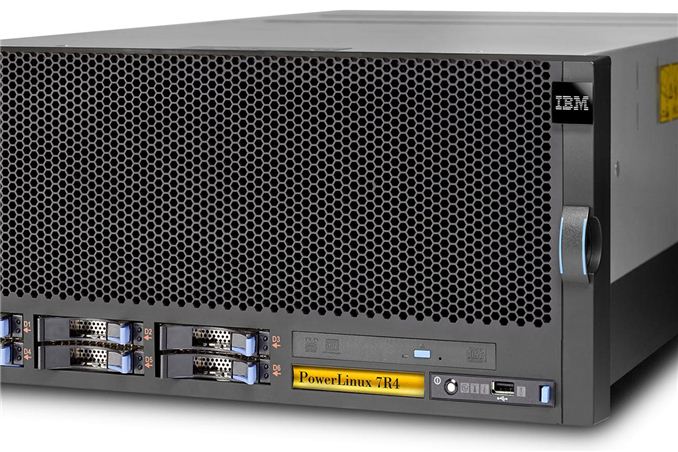IBM Offers POWER Technology for Licensing, Forms OpenPOWER Consortium
by Jarred Walton on August 7, 2013 1:32 AM EST
The CPU wars are far from over, but the battlegrounds have shifted of late. Where once we looked primarily at the high-end processing options, today we tend to cover nearly as much in the ARM licensing world as we do in the x86 world. IBM is joining with Google, NVIDIA, Mellanox, and Tyan to create the OpenPOWER Consortium, with the intent being to build advanced server, networking, storage, and GPU-accelerated technologies based on IBM’s POWER microprocessor architecture. High performance computing clusters and cloud computing are other areas of focus for OpenPOWER.
Along with the forming of the OpenPOWER Consortium, POWER hardware and software will be made available for open development for the first time, and POWER IP will be licensable to others. (While not stated explicitly in the news release, Ars Technica's Andrew Cunningham reports that licensing will begin with POWER8.) Steve Mills, senior vice president and group executive at IBM, states, “Combining our talents and assets around the POWER architecture can greatly increase the rate of innovation throughout the industry. Developers now have access to an expanded and open set of server technologies for the first time. This type of ‘collaborative development’ model will change the way data center hardware is designed and deployed.”
The NVIDIA aspect is also interesting, considering how many of the Top 500 Supercomputer list now use some form of GPU. Sumit Gupta from NVIDIA’s Tesla Accelerated Computing Business states, “The OpenPOWER Consortium brings together an ecosystem of hardware, system software, and enterprise applications that will provide powerful computing systems based on NVIDIA GPUs and POWER CPUs.” Considering NVIDIA has also announced their intent to license Kepler and future GPU IP to third parties, we could potentially see SoCs in the coming years with POWER-based CPU cores and NVIDIA-licensed GPU cores in place of the common ARM and PowerVR solutions so prevalent today.
This is clearly intended to slow and perhaps even reverse the exodus seen from the POWER architecture over the past decade. Apple switched from POWER to x86 back in the Core 2 Duo days (2006), and after getting wins in both the current generation consoles (Xbox 360 and PlayStation 3) the next generation Xbox One and PlayStation 4 will both be going with x86 designs. Many are likely to see this as vindication of the IP (Intellectual Property) licensing route taken by ARM, with NVIDIA, and now IBM all looking to license their IP (not to mention AMD and others licensing ARM IP). Considering the decline in POWER use in recent years, this move should help give POWER more relevance in the future.
Source: IBM News Release










29 Comments
View All Comments
Kevin G - Wednesday, August 7, 2013 - link
Nothing directly. nVidia has already stated that Project Denver is an ARM based design.Any future POWER plans with nVidia will be under a different project name.
TooYellow - Wednesday, August 7, 2013 - link
It's disingenuous to call something "open" then license it to people.JarredWalton - Wednesday, August 7, 2013 - link
You can create open software on POWER now, while if you want to build your own CPU/SoC you need to license. So it is open from the software angle. That's my understanding at least -- I don't think POWER7/POWER8 were open in this way before, though some of the earlier POWER instruction sets are.Kevin G - Wednesday, August 7, 2013 - link
IBM had licensed earlier PowerPC cores which are ISA compatible with the POWER chips.In fact, the only difference between POWER and PowerPC at this point is marketing and artificial segmentation.
WeaselITB - Wednesday, August 7, 2013 - link
IBM has been in the process of divesting their hardware divisions for years ... this seems like another logical step in the overall scheme. Get a consortium together, license the IP, eventually sell off the IP to the consortium -- a nice, clean way to break ties with hardware while still maintaining ties with hardware.-Weasel
haihuynh - Wednesday, August 14, 2013 - link
bop nuloa_dir - Wednesday, August 14, 2013 - link
Is it really true that the use of POWER is diminishing? Yes, on consumeroriented hardware, definitely. But I think that IBM is very well positioned in the server, mainframe and HPC market. I remember reading somewhere that about half of IBMs profits comes from products with POWER processors, and services and software for that hardware. That means IBM is making about 8bn $ /year of profits on the POWER chips. You seldom make that big profits on an architecture that is heavily declining.shodanshok - Wednesday, August 14, 2013 - link
If I correctly remember, about half of IBMs profits comes from _mainframes_, ergo SystemZ installation. Probably the upper-end Power installations can be considered mainframes also, so this data can include some Power system also. However, SystemZ is the mainframe system of choice for IBM. I fear that for widespread Power usage is too little, to late, but I hope to be wrong ;)ultimatebob - Tuesday, August 20, 2013 - link
I guess that it's nice that companies are now deciding to open source their dying technology products now, but moves like this never seem to save a product from extinction.Some good examples of this "death by open source" maneuver are Open WebOS from HP/Palm, MeeGo from Intel/Nokia, and the opening of the BeOS source code.